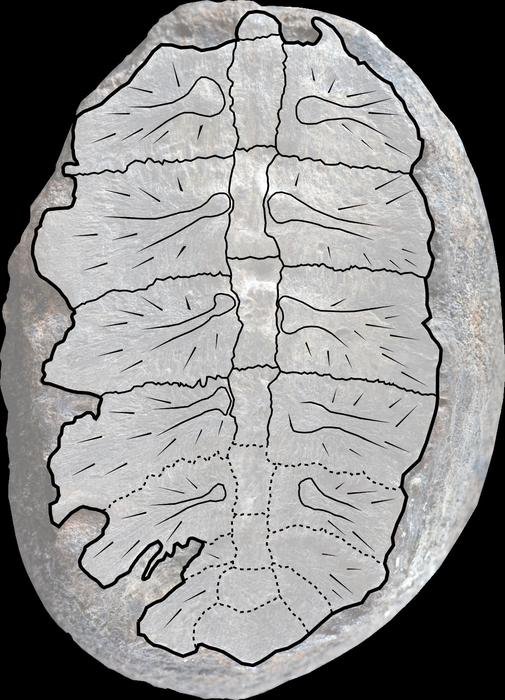A curiosity found within a trove of ancient plant fossils from the Cretaceous period has been revealed to be something else entirely, in a rare discovery that recently took a team of researchers entirely off guard.
The surprise findings came amidst a collection of fossils retrieved near the Columbian town of Villa de Levya by Padre Gustavo Huertas between the 1950s and 1970s, consisting of small rounded patterns in stone that the priest originally labeled as fossil plants of the genus Sphenophyllum.
The designation was problematic, given that other examples of this genus had already died out more than 100 million years before the Cretaceous period, an issue that caught the attention of Fabiany Herrera, Negaunee assistant curator of fossil plants at the Field Museum in Chicago, and his student, Héctor Palma-Castro, a paleobotany student at the Universidad Nacional de Colombia.
“We went to the fossil collection at the Universidad Nacional de Colombia in Bogotá and started looking at the plants,” Herrera recently said. Once he and his student had photographed the anachronistic fossils, the pair found the situation even stranger.
This was particularly the case for Herrera, whose many years in the field have focused on the collection of South American plant fossils from the Early Cretaceous. The fossils did initially appear to possess features consistent with fossils of the plant Sphenophyllum; however, something did not look right, prompting Herrera and Palma-Castro to spend several days going through cabinets of fossil plants to try and make further comparisons.
One key feature they noticed had been a series of small lines that were present in the fossils from the Columbian priest’s collection. Although generally consistent with the location and appearance of veins in the leaves of Sphenophyllum plants, something still seemed unusual.
On closer inspection, Herrera suddenly recognized what he was seeing.
“I was positive that it was most likely bone,” Herrera revealed.
Following Herrera’s discovery, he sent photos of the fossils to his colleague Edwin-Alberto Cadena, who, after viewing them, also thought they were most likely bone and put forward an additional idea about what they had been observing.
“This definitely looks like a carapace,” Cadena said, “the bony upper shell of a turtle.”
Although Cadena, a vertebrate paleontologist at the Universidad del Rosario in Bogotá, was certain that the specimens he was viewing were of an ancient, shelled reptile rather than a plant, he was surprised nonetheless.


“Well, this is remarkable,” Cadena said upon making the recognition, “because this is not only a turtle, but it’s also a hatchling specimen, it’s very, very small.”
“When we saw the specimen for the first time I was astonished, because the fossil was missing the typical marks on the outside of a turtle’s shell,” according to Diego Cómbita-Romero, one of Cadena’s students at the Universidad Nacional de Colombia.
Another oddity of the fossils was their shape, which Cómbita-Romero said was “a little bit concave, like a bowl.”
“At that moment we realized that the visible part of the fossil was the other side of the carapace, we were looking at the part of the shell that is inside the turtle.”
Based on the thickness of the bones and other features indicating the turtle’s age, Cómbita-Romero said that all indications were of a juvenile that had died and was preserved while still in the post-hatchling stage.
Cadena said such discoveries are extremely rare since the bones in juvenile reptiles—turtles in particular—are thin and, therefore, more easily susceptible to destruction before fossil preservation can occur.
As to the misidentification, the researchers all conceded that the original labeling of the fossils as Sphenophyllum colombianum was forgivable since the ancient reptile’s bones along the inner portion of its shell had been preserved in a way that almost perfectly resembles how the plant appears in fossils from much earlier periods.
“The Early Cretaceous is a critical time in land plant evolution, particularly for flowering plants and gymnosperms,” Herrera said in a press release. “Our future job is to discover the forests that grew in this part of the world.”
“We resolved a small paleobotanical mystery, but more importantly, this study shows the need to re-study historical collections in Colombia,” Herrera said.
The discovery was recently detailed in a paper, “An Early Cretaceous Sphenophyllum or a hatchling turtle?” published in Palentologia Electronica.
Micah Hanks is the Editor-in-Chief and Co-Founder of The Debrief. He can be reached by email at micah@thedebrief.org. Follow his work at micahhanks.com and on X: @MicahHanks.

